By Elaina Burress and Hana Bracale
Today I sat in on one of the few (if not only) COP22 side events on the impacts of animal agriculture in driving climate change. Speakers came from Brighter Green (a US non-profit action tank with a focus on food policy and equity), Humane Society International, and the Global Forest Coalition (an organization working for socially-just forest policy, with a special focus on Indigenous Peoples’ rights).
A local Moroccan woman with the Pan-African Animal Welfare Alliance (PAAWA) also spoke on the topic, explaining what animal agriculture and climate change mean for her country, and putting these themes into a very real, very tangible perspective as we gather in Marrakech for COP22.
Brighter Green (BG) opened the side event asking “Why animal agriculture?” They quickly answered their own question: because it induces climate change and severely uses natural resources, threatens food security and land rights by necessitating large amounts of agricultural land for feedstock production which could otherwise be used to feed humans directly, harms public health by increasing rates of diabetes, heart problems, and cancer, deprives animals of welfare and basic rights, leads to species and biodiversity loss due to deforestation, and has a great affect on the livelihoods of small farms, the women running them, and on equity and sustainability.
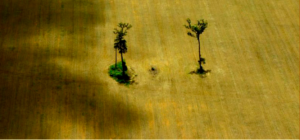
BG followed this up with some statistics, noting that more than 70 billion animals are killed yearly for food worldwide, that the average American eats over 230 pounds of meat per year – whereas the rest of the world eats about 74 pounds, though this is steeply increasing as developing countries gain wealth – and that meat and dairy use 30% of the Earth’s land surface and nearly two thirds of all agricultural land.
For this reason, it is important that we, as consumers, realize that this is not only an issue of meat consumption, but of the consumption of all animal agriculture products, including dairy and eggs.
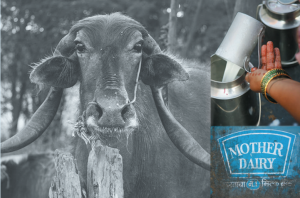
One huge problem with animal agriculture is not only that it uses a tremendous amount of land, but that it does not use this land effectively. Land used to grow soy as feedstock for cattle could produce significantly more food for direct consumption by people, and could do this using less resources, and with less negative environmental impacts and fewer greenhouse gas (GHG) emissions.
It is also important to realize the growing demand for meat, dairy and eggs, and the varying levels of consumption by different countries. For example, in China, eating pigs was traditionally reserved for the very wealthy, but is increasing tremendously as more and more people enter the middle class and see pork consumption as a sign of wealth and prosperity.
As of today, China consumes half of the world’s pigs, and this amount is quickly growing.
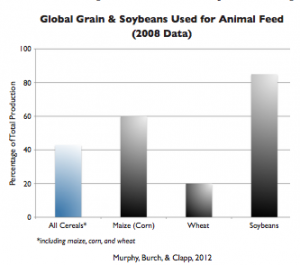
Furthermore, developing countries are replicating developed countries intensive animal production model, utilizing intense feedlots overcrowded by cattle forced to stand in their own waste, small battery cages for egg laying hens, and intensive hog production sheds with restrictive cages and cement floors that do not allow for movement or comfort.
These models lead to massive water pollution, increased necessity for antibiotics, and spikes in the frequency of food borne illness breakouts (70% of food borne illnesses in the last ten years have been sourced from animal products), as well as the perpetuation of severe injustices in regards to animal welfare and animal rights.
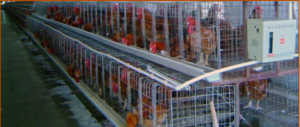
So how do we feed this demand? And can we? It is obvious that animal agriculture and it’s waste lagoons (most common on pig farms) are unsustainable and terrible for the environment, and this has become even more crucial for the US after Hurricane Matthew flooded North Carolina, and spread animal waste from lagoons across the southern states.
Furthermore, the hurricane drowned/killed hundreds of thousands, if not more, pigs and cattle, as well as millions of birds. Thus, part of the problem of animal agriculture and its un-sustainability lies in its cleanup: the cleanup of the dead animals and the waste they produced before their death.
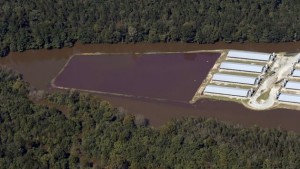
Most of the farms involved in this incident are owned by the WH group bought by Smithfield, which is currently owned by one of China’s largest meat processors: Shuanghui International Holdings, which owns more than a fourth of all the pigs in America. So if China owns America’s farms… Who is in charge of cleaning up? Of funding the cleaning up? Who’s in charge of the dead animals? The waste lagoons?
In this case, it is North Carolinian taxpayers and other US citizens. Because there is no commercial responsibility (or transparency) of these farms, it will be US taxpayers who pay for the clean up. As for the physical clean up, that is often left to undocumented immigrants, women, and people of color paid severely below the minimum wage.
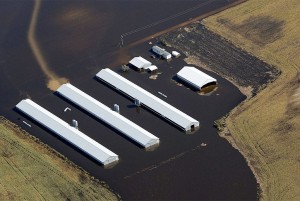
In closing her speech, Brighter Green left the audience with some more statistics, stating that over 80% of soybeans, 40% of cereals, and 60% of maize go to feeding farm animals, NOT humans. A quarter of GHG caused by humans results from agriculture and changes in land use related to production of crops and farm animals.
If we continue on this track, BG states that by 2050 we will double production, as demand is increasing and will have doubled as well. In this future, agriculture alone will emit over 20 gigatons of CO2e.
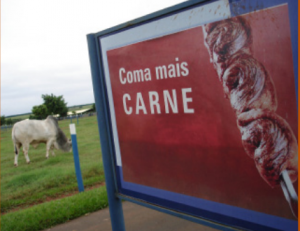
So how do we move forward? It is suggested that we promote alternative visions and public policies, as governance is FAR behind and unwilling to address consumption patterns. We must also improve and support alternatives on the supply side, as plant based meats offer market based solutions to the situation – people will not change their habits unless it is DELICIOUS solution as well!
This, however, MUST be paired with solid policy changes.

Tozi Zokufa from the Human Society International spoke second, stressing the importance of water in animal agriculture and agriculture’s negative impacts on climate change. Animal agriculture uses over 30% of global agricultural water requirements – which, if taken into account how few people meat is able to feed in comparison to primary produce, becomes even more astonishing – and, thus, enhances already prevalent water scarcities.
South Africa and many other parts of Africa are already experiencing severe water scarcities, and by 2023 it is predicted that nearly 33% or more of the world’s population will live in areas of absolute water scarcity.
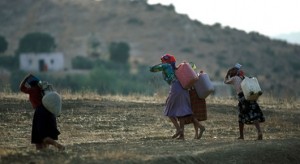
Zokufa points out the inconsistencies happening with green initiatives in other sectors versus those (not) happening in the agricultural sector. When we talk about climate change, he notes, we do NOT talk about sustainable diets. Is it too personal? Does it feel too judgemental? Why can’t we talk about it?
We need to be thinking about the impact of the food we eat, now more than ever. We need to be questioning the product itself, as well as its packaging and the lives of the animals who have died to provide it. It is not just the car you drive that has an impact on climate change and emissions, but also the food that you eat.

In his speech, Zokufa pointed out the ways in which we DO act to combat climate change: by not taking daily showers, by carpooling, taking the train instead of our cars, and many more. Some of us are even conscious about the clothes that we buy and where they are sourced from, how the workers there are paid, etc.
So why don’t we substitute soymilk for cow’s milk? Or substitute the meat on your plate with meat substitutes or a combination of plant-based alternatives such as rice and dal, beans and rice, fermented soybeans, and other culturally appropriate vegetarian options?
It starts with our plates… and it seems so simple! All we have to do is be thinking, be conscious, like we are about our showers and our clothes, about what we’re eating for breakfast, lunch and dinner, specifically in regards to its environmental impact, health impact, and animal welfare standards.
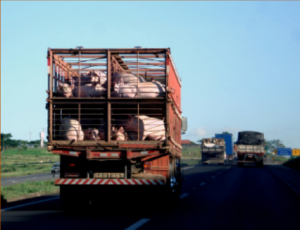
As a solution, the Humane Society International offered an idea I found incredibly disappointing and inadequate: Green Monday. Green Monday suggests, alongside the UN (which is known for its slow, conservative and insufficient suggestions), one vegetarian meal a week to combat climate change. One vegetarian meal “for the planet”.
Agriculture is one of the most significant contributors to serious environmental degradation at every scale from local to global. So ONE vegetarian meal a week? Where we still can consume dairy and/or eggs? Many of us eat three meals a day, which adds up to 21 meals a week. That makes only .04% (or .05% if you kindly round up) of our weekly meals that we refrain from eating products that we know are terrible for the environment.
We can do more. We must do more.
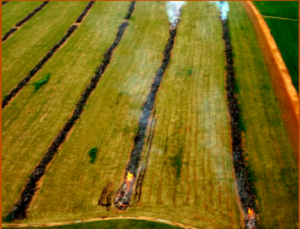
The Global Forest Coalition brought up issues of rights, and the impacts of public private partnerships in animal agriculture/livestock farming. She stressed the importance of taking a rights-based approach to agriculture, noting the rights and needs specifically of local indigenous communities, especially those living in forests. Animal agriculture has been and currently is an underlying cause of forest loss.
As she said, “the impacts are crystal clear”. While there are positive examples, of which she listed India and its unique system of small-scale pastoralism (letting the cows graze and wander wherever they please throughout the day, regrouping them at night, milking them in the morning), these systems work on a small scale, and cannot co-exist with large scale industrial agricultural of meat, or the soy production required for its feedstock.
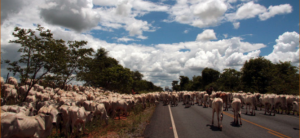
India, for example, in its current policies and trends in the livestock production sector, favors corporate concentration and the expelling of small producers, most being women from the country-side. Brazil, as another example, has a huge concentration in the cattle producing sector as well as the processing sector, which has led to the forced evacuation of many people from their homelands for livestock production.
Ireland has set its focus on offsetting, claiming that the livestock issue is not an issue because they’re planting trees to offset its emissions. So while many communities all over the world DO practice sustainable agricultural practices such as pastoralism, free-range animal agriculture, agroecology, and multi-use agriculture, these practices are incompatible with current global demand.
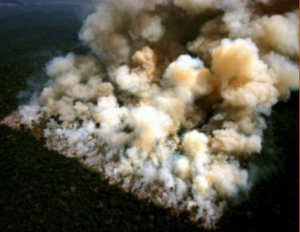
The UN, however, is still promoting, or at least failing to address, this false coexistence. By supporting corporate and industrial models that outcompete small farms, and by favoring public-private partnerships that lead to the protection of large farms, it undermines the resilience and feasibility of small farming systems.
Thus, a choice must be made. We must reconsider private collaboration, and the financial dependency it has created of the government under the UN (and the UN itself) on private sectors. These subtle financial dependencies further steer action towards private sectors.
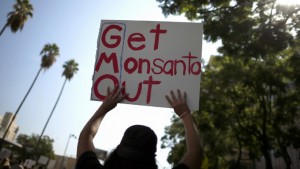
Furthermore, we need measures that are both qualitative and quantitative. We have to reduce production in the livestock sector. We must set the limits that corporations refuse to set themselves: on economic growth at any expense.
Producers do not want to set limits on their own growth, and rather than talking about reduction, they often talk about reframing the issue, ignoring massive pesticide poisoning while insisting on it’s crucial importance for ensuring sufficient food production.
Lastly, we must acknowledge women’s restoration and reforestation initiatives in indigenous communities, and their influence on promoting ecological integrity.
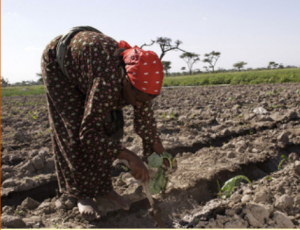
Finally, bringing this into the perspective of Morocco, the last speaker spoke of changes in Moroccan diets and eating patterns. She explained the ways in which Europeanization in Morocco has led to a change in eating: of eating more animal products, and of food becoming more corporate.
While just 15 years ago it was nearly impossible for families to eat outside of their houses, now, due to increased demands of work, time for lunch and dinner are getting shorter and people are staying in and around their offices to eat meals. For this reason, she urges that when thinking about food, we must also think about the way that people work.
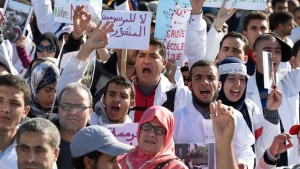
Furthermore, she noted that animal rights in Morocco are terribly insufficient: animal well being is not a part of agriculture (similar to many other parts of Africa), and only one slaughterhouse in all of Morocco actually meets the EU’s standards for health and humanity. Moroccans must cook their meat for long periods of time in dishes such as tajine, or else it would be unsafe to eat.
Moroccans are also increasingly struggling with diabetes and obesity as income and wealth have increased and people are investing more in expensive, Western diets.

The speaker also urged that although this seems like a basic and simple thing to think about, you cannot simply tell the Moroccan people to be vegetarian for the environment. They might respond, she said, by saying, “Now that I have the money to buy these (animal) products, you tell me I can’t? You have been able to eat these products, why can’t I?”
Additionally, she spoke of the “greenness” of Morocco, and how many people believe that since Morocco is green and looks healthy, that it actually is.

Furthermore, the messaging used to communicate about issues of climate change has been too frightening. In this way, it is treated like a scandal and forgotten about quickly. Perhaps efforts would be more productive if messaging was more positive, or if options to change one’s diet were cheaper.
Additionally, the ministry must be involved in any transitioning process. They cannot go far without the help of the ministries, as she feels that NGOs can only do so much. Thus, we must make both the people and ministries aware in order to change the “reality”. She feels we must work with our leaders.
—————————————————————————–
It is very clear that animal agriculture is a threat to environmental health and climate justice. So my question is: why isn’t it in the Paris Agreement? Why isn’t it being dealt with in COP22 – the COP of Action? Or as more than a negligible mention within countries’ National Determined Contributions (NDCs)?
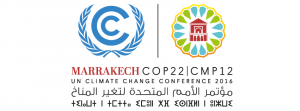
The preamble (which is not part of the “operational” text) of the Paris Agreement recognizes the “fundamental priority of safeguarding food security and ending hunger, and the particular vulnerabilities of food production systems to the adverse impacts of climate change”. However, by specifying food production systems, it fails to include any room for considering consumption patterns.
Meat, primarily consumed by the wealthiest citizens of developed countries and transition countries, is almost entirely left off the table, with no willingness to consider whether or not it should be there.
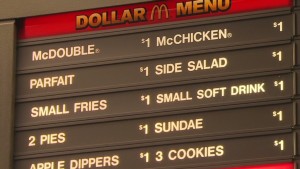
This further raises the question of meat in lobbying: How powerful is the meat lobby? Is the meat lobby more powerful than the environmental lobby? While this might be scary to realize: I would argue that it is.
Furthermore, I would argue that it is ridiculous the way we talk about these issues, that we talk about bioengineering cows before we talk about changing our daily diets.
We talk about intensification in terms of food security (which at COP22 has taken on the meaning of food intensification), rather than talking about what just agriculture might look like: food sovereignty.
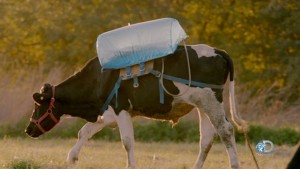
Food sovereignty takes into account more than just access to food. It is defined by La Via Campesina as “the right of peoples to healthy and culturally appropriate food produced through sustainable methods and their right to define their own food and agriculture systems”.
This term much better addresses issues of climate justice than the term food security… at least until it is manipulated in the next COP.
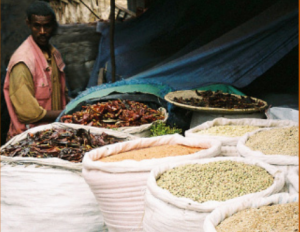
For these reasons, it is clear that the Paris Agreement is based on the assumption of finity: of finite elements. We are not holistically thinking about the causes of food security, of food sovereignty. We are not thinking about distribution access.
Finally, we are addressing this issue as personal when it is so clearly political. We’ve tried to talk about climate change aspects and the Paris Agreement without getting too personal, completely avoiding the personal because it is personal – not telling people what to eat because it is their individual choice – even though climate change DOES and will always affect the personal.
Climate change is inherently personal. Just as Zokufa from the Humane Society International pointed out, people feel judgment and take offense when we start talking about sustainable diets, when we start recommending changes on what they should be eating.
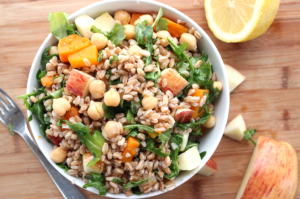
Perhaps then, the solution lies in changing the way we look at our diets, in seeing them not only as personal choices, but also as political ones, as an outlet for political change and direct action.
Maybe with this mindset it will be possible to bring animal agriculture and our personal diets into the context of the Paris Agreement and other solid policy (and perhaps international) decisions.
